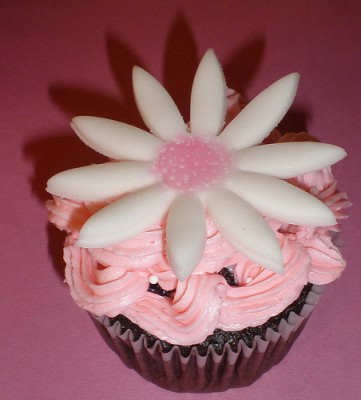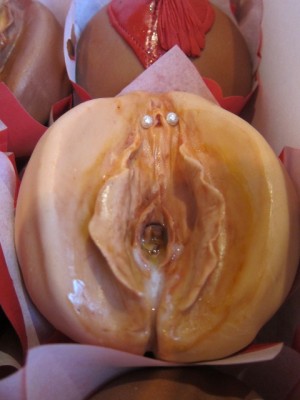THE MINUTE YOU forbid yourself – and indeed others – from doing something, the more mysteriously compelling it seems, as though the cosmos is concentrating its energy on leading you towards the taboo. Last week in this hallowed space, I proposed a ban on conversation about female genitalia, on the grounds that we were all sick of the subject. A few days later, I’m walking down the street to the pub with two friends, one male, one female, when my eye is caught by the image of a giant cupcake in a store window. It’s the pink and swirly kind. To be fair, there aren’t very many other kinds, but this one was especially glittery, the folds of its icing particularly ridged, the curve of its sponge noticeably hip-like. I’m a bit taken aback.
“Christ,” I say. “I thought we were finished with those. Are they still a Thing?”
“Yeah,” replied the man. “What is that all about?”
At that moment, I’m not sure what happened. I hadn’t been thinking about them, by which I mean cakes or genitalia, at all. I promise. It was just a strange synaptical twist. Anyway, without more than a second’s pause, I said –
“They’re about making vaginas less scary.”
There was a momentary pause while my companions digested this theory.
“Wow,” said the woman. “I did not expect you to say that.”
“No,” I replied. “Nor did I. I wonder if it’s true?”
“No, no!” said the man. “It’s brilliant. Don’t worry about whether it’s true or not.”
I knew what he meant, but nonetheless, I have been ruminating on it – in a relaxed sort of a way – ever since; just occasionally prodding it to see whether it holds any water whatsoever, or whether it was something that fell out of my mouth, perhaps because a) I was unconsciously rebelling against my self-imposed vagina ban, b) I was attempting to set the tone for the pub by galvanising everyone with a mention of genitalia and/or c) I was just reassuring myself that my personal social milieu is totally comfortable with the unexpected deployment of vaginas in casual, mixed-gender conversation. Hey! Not just comfortable! We insist on it!
It could also just be that I have been a journalist for a long time and am now conditioned to fill every silence with the first sentence of an op-ed piece.
I tested it when I got home that night, on a man in my house. “Don’t be ridiculous,” he scoffed. “They’re not vaginas. They’re tits. That’s why women are always pictured proffering them to you on large trays, and that’s why they always have nipples on top.”
“Nipples?”
“Well, things like cherries, for example.”
“No! Cherries are clitorises.”
Two NBs here: this exchange actually happened. If I were making it up, I’d have retrospectively portrayed myself as someone who used “clitorides” as the plural of clitoris. Second NB: the course of the conversation might have been influenced by the fact that I was once photographed, for a humorous piece about the art of home-making, in front of a dish of cupcakes with cherries on top, wearing an apron covered in printed cupcakes, also with cherries on top. I myself had been decorated in the style of the 1950s and, to this end, an extremely nice person had arrived at my house early in the morning to transform my hair and make-up. My abiding memory is of her with a mouthful of hair-pins, repeatedly switching her gaze from me to a photograph of Christina Hendricks. And back again. She deserved a medal. When she had finished, I showed myself to my spouse equivalent. “What ho,” he said, not without a trace of bitterness. “It’s Britain’s least surrendered housewife.”
I digress.
Of course, I know what I meant about the cupcake vaginas: I meant that they attempt to present femininity as something fluffy and frosted, sweet and yielding and a bit silly. They suggest that women will emerge from the kitchen with an unthreatening treat rather than something aggressive and spiky, like… a chilli? A fish with lots of difficult bones? Pumpernickel? Hmm. Perhaps there’s an awful lot less to my theory than meets the eye.
But, as every sensible life coach is no doubt queuing up to tell me, it’s important that I don’t blame myself. I have, after all, been swimming in sexuality soup for weeks now. On the one hand, women everywhere have been wondering they would have eaten the vulva-shaped pasta parcels that Naomi Wolf’s friend so wittily dubbed cuntini (quick aside: has anyone signed that chap up to write a cookery book?). Most say they would, but it’s easy enough to say, no? Also: there’s something dodgy about the near obsessional repetition of that anecdote, together with the bit in the book that suggests that if you get your back fixed you will experience mystical climaxes quicker than you can order a bowl of gender-neutral ravioli. Sure, both make Wolf look like a bit of an attention-seeking oddity; but going on and on about it has made her detractors look decidedly odd and not very sisterly themselves.
Luckily, however, those of us in the UK whose appetites for sauced-up mealtimes have been piqued by all this naughtiness have only a few hours to wait until the return to our television screens of Nigella Lawson. Her new series, Nigellissima, is about to turn us all mad for “instant Italian inspiration”; but the antipasti is the first course in more ways than one. Thousands of words have been written about the extent to which Nigella is aware of the effect she has when she pushes her lips out and flashes her eyes during her recipe demonstrations; when her television shows, most of which take place in a set intended to look very much like a real domestic space, conclude with her slipping down to a darkened kitchen in a silky nightrobe to polish off some seriously decadent leftover chocolate cake; when she allows herself to be photographed for a magazine cover dripping with salted caramel. Usually, if she responds at all, Nigella feigns a sort of amused – and amusingly unconvincing – innocence, and then goes on her merry way; when I last looked at her website, its front page featured a recipe for spaghetti carbonara to be eaten in bed on the occasion of your first “whole night” with a new partner, complete with instructions to make more than you need and work up an appetite for seconds. Coo!

Nigella, life hasn't always been a bowlful of cherries. That said, she is married to Charles Saatchi and her dad was a minister in Thatcher's government.
Nigella’s sex schtick is sweet. Sure, it is built on the idea of a woman of appetites so great that it takes a really big helping to satisfy her. Really, though, I wonder if it doesn’t mask something a little more subversive. Lawson, as her aficionados and many others will know, has hardly had an easy life; she might have come from a wealthy and privileged family, but she also endured the early deaths of her mother, her sister and her first husband. You could see the flirtatiousness and sexiness as a kind of joyfulness at survival; and I think the fantasy that Lawson peddles is not so much one of permanent sexual arousal but rather one of solace. Learn to cook, says Lawson, and you will always have a way to provide yourself with comfort; there will always be a way to satisfy at least the most basic of your yearnings; the possibility of the nurtured life will persist.
It might not be true, but it doesn’t seem so very harmful. Why, then, should I be irritated by a pink cupcake? Perhaps because at least when you cook a Nigella recipe you end up with a nice stew rather than a silly little confection that, after the initial excitement, doesn’t even bother to call the next morning.






Pingback: Food Links, 24.10.2012 | Tangerine and Cinnamon
I enjoyed this article and learning something about Nigella. I even went to her website. I consider myself a sensual person; however, I don’t see my self ever consuming let alone purchasing a vagina shaped cupcake. (i)